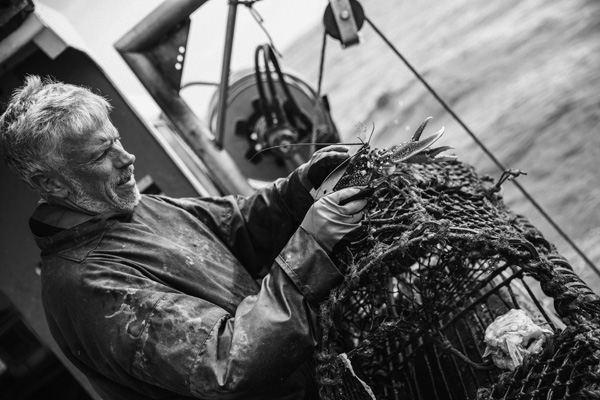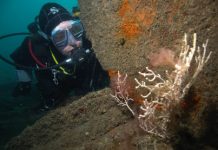Amongst all the bad news about the state of the oceans—overfishing, dying coral reefs and plastic pollution—it is a welcome relief to hear of a real conservation success story where fishermen and scientists are working together to protect marine life and the livelihoods of their communities. It is particularly heartening to know that this story is unfolding on our doorstep, in the heart of Lyme Bay.
The Lyme Bay Fisheries and Conservation Reserve straddles the border between Dorset and Devon along the beautiful Jurassic Coast. It was created in 2008 with a Statutory Order that banned fishing with “mobile gear”, such as bottom-trawls and scallop-dredges, in an area of 60 square nautical miles. The reserve was further increased in 2010 to 90 square miles making it the largest of its kind in UK waters. Its aim was primarily to stop the destruction of nationally significant marine species, like the ross corals and Pink Sea Fans that are a particular feature of Lyme Bay. The ban on trawling and scallop-dredging not only allowed these and other delicate organisms to recover, but also led to a rapid increase in the number of lobsters, crabs, cuttlefish, sole and plaice that rely on a stable and structured seabed for food and shelter. News of the good catches in Lyme Bay quickly spread and attracted more fishermen from as far as Cornwall and the Solent. By 2012 the use of “static gear”, such as pots and nets, had increased to unsustainable levels, reducing catches and threatening further damage to the protected reefs inside the Reserve. The challenges for the Lyme Bay Reserve had in some ways just began.
To help address these management problems, DEFRA asked the Blue Marine Foundation to establish a multi-stakeholder working group in Lyme Bay. A working group was formed in 2012 of scientists, fisheries managers and fishermen from the 42 small boats (under 10 metres) that operate out of the four ports in the Reserve—Beer, Axmouth, Lyme Regis and West Bay. The initial meetings were challenging to say the least, as many fishers were still aggrieved by the Statutory Order of 2008 that they felt had been imposed on them by the Government. With the Blue Marine Foundation acting as facilitator, the working group managed to overcome these past conflicts and developed the Lyme Bay Fishermen’s Voluntary Code of Conduct.
This code of conduct includes restrictions on the number of pots and the length of nets that a fisherman can use, and also requires special tracking devices to be fitted to their boats to monitor where fishing occurs so that the fish can be labelled as ‘fully traceable’ under the Responsible Fishing Scheme. The code also requires that lobster pots be fitted with small hatches to ensure undersized lobsters can escape, and that cuttlefish eggs, which are often laid on pots and other gear, be allowed to hatch before the pots are cleaned.
Angus Walker, a long-standing fisherman from Axmouth and Vice-Chairman of the East Devon Fishermen’s Association (Seaton and Axmouth Branch) was originally opposed to the Statutory Order, which forced him to sell his trawler and buy a smaller boat. He now acknowledges the benefits that the reserve and the code of conduct are generating. “The fish in the reserve are of better quality, the sole and plaice are fatter and in better condition, and can fetch a higher price” he told me. He believes the “lack of disturbance of the seabed is helping to sustain a healthy food chain. The catches of lobster and crab have also improved, and this is helping to sustain the livelihoods of local fisherman”. John Worswick, a scallop diver who has been operating out of West Bay for the past 20 years, has also seen his catch increase—“Had the reserve not come in, I would not be in business as a scallop diver” he said with confidence. Nigel Birt, who fishes from Lyme Regis and runs the “Lyme Bay Fish Shack” also supports the Reserve: “It is helping to support our inshore fishing industry and hopefully attract younger fishermen into the sector. There is no doubt it is sustaining our fish stocks and increasing the diversity of species we can catch”. Angus, John and Nigel are confident that almost all the fishermen in Lyme Bay adhere to the voluntary code of conduct, because they understand the importance of conservation and have a vested interest in the future of their local inshore fishery.
Marine biologists from Plymouth University have been monitoring the Lyme Bay Reserve for 10 years, the longest dataset for any marine protected area in the UK. Their results show that the combined effects of the ban on mobile gear and the voluntary code of conduct have led to an impressive increase in the flora and fauna of reef species. There was an eightfold increase in the number of pink sea fans, with anemones, corals and sponges also recovering. These delicate animals are critically important in providing habitat for fish and shellfish. King scallops were estimated to be seven times more abundant inside the Reserve compared with areas still open to dredgers. Landings of scallops from inside the Reserve more than doubled between 2008 and 2014, and these fetch a 20% premium as they can be guaranteed “hand-dived”. In 2014, average monthly landings of edible crab were approximately 450 kilos—more than two and a half times those in 2008. Juvenile lobsters have increased fourfold inside the Reserve, and a recent report by CEFAS said “current voluntary measures are better than those in place in other areas of the country” and will “ensure the sustainability of the lobster fishery in the long term”.
These results are very impressive in themselves but to help fishermen further, the Blue Marine Foundation provided chiller units, cold rooms and ice making machines in the Reserve’s four ports. The high quality and traceability of the catch from the Lyme Bay Reserve have allowed a new food quality label to be developed called “Reserve Seafood”. Wholesalers in London now pay a 10% premium for “Reserve Seafood” and provide a market for a wider range of finfish such as sole, plaice, pollack, mackerel and skate.
The Blue Marine Foundation is now looking to use the Lyme Bay model in other parts of the UK. Its success is due to wide a range of factors but central among them is the backing and engagement of local fishermen in all aspects of management. As Angus told me “scientific monitoring is very important and we are using an ecosystem-based approach, not simply focusing on single species…. In the future I would like to see the Reserve expanded as far as Portland Bill to the East and for us to have our own Reserve manager.”
While the future of fisheries management is full of uncertainties, one thing is clear, the inshore fishermen of Lyme Bay have taken control over the marine resources on which they depend and established their own successful model of collaborative management. The Reserve has become a flagship of which we can all be proud and should be replicated around our coasts.
Thanks to Angus Walker, John Worswick and Nigel Birt for sharing their insights and experience. Thanks also to Adam Rees from Plymouth University and Morven Robertson from the Blue Marine Foundation for scientific reports and photos.
Owen Day, PhD. is a coastal scientist with over 20 years’ experience in fisheries, marine protected areas and ecosystem-based adaptation to climate change.
References:
http://www.lymebayreserve.co.uk/
https://www.facebook.com/LymeBayReserve/
Lyme Bay Fisheries and Conservation Reserve Ecological and Fisheries Data
Lyme Bay – A case study: measuring recovery of benthic species, assessing potential spill-over effects and socio- economic changes
https://www.dropbox.com/s/hg2sxiec1nexvzy/Lyme_Bay_Closed_Area_Monitoring_2008-2010_MBI.pdf?dl=0
An evaluation framework to determine the impact of the Lyme Bay Fisheries and Conservation Reserve and the activities of the Lyme Bay Consultative Committee on ecosystem services and human wellbeing.
https://pearl.plymouth.ac.uk/bitstream/handle/10026.1/6742/Evaluation%20framework%20to%20determine%20the%20impact%20of%20the%20Lyme%20Bay%20Fisheries%20and%20Conservation%20Reserve%20on%20ecosystem%20services%20and%20human%20wellbeing_Final.pdf?sequence=1&isAllowed=y
Recovery of a Temperate Reef Assemblage in a Marine Protected Area following the Exclusion of Towed Demersal Fishing
http://journals.plos.org/plosone/article?id=10.1371/journal.pone.0083883
Lyme Bay Fully Documented Fisheries Trial









